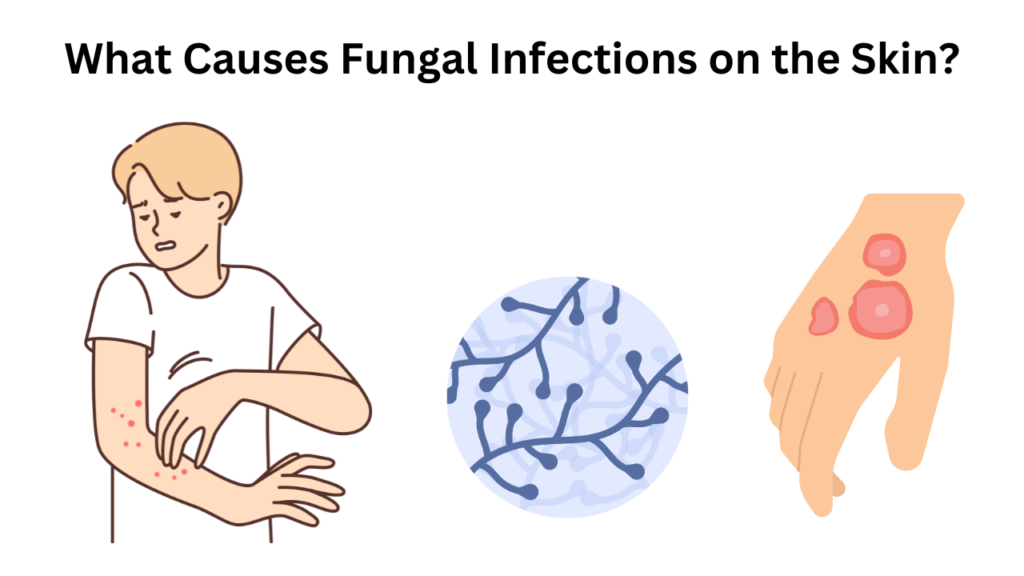Fungal infections are a common occurrence on the skin, affecting millions of people worldwide each year. These infections can be uncomfortable, unsightly, and sometimes challenging to treat if not managed properly. In this blog post, we will delve into the causes, symptoms, and treatment options for fungal infections on the skin, providing you with the knowledge to recognize and address these issues effectively.

Fungal infections on the skin, also known as dermatophytosis or tinea, are primarily caused by fungi that thrive in warm, moist environments. The most common types of fungi responsible for skin infections include dermatophytes such as Trichophyton, Microsporum, and Epidermophyton. These fungi can be found on surfaces like floors, towels, and clothing, making them easily transmissible through direct contact with infected persons or contaminated objects.
Factors that contribute to the development of fungal infections on the skin include:
- Warm and Humid Environments: Fungi thrive in warm, moist conditions, making areas such as locker rooms, swimming pools, and communal showers common sources of infection.
- Weakened Immune System: Individuals with compromised immune systems are more susceptible to fungal infections. This includes people with conditions like HIV/AIDS, diabetes, or those undergoing chemotherapy.
- Skin-to-Skin Contact: Direct contact with an infected person or sharing personal items like towels or clothing can facilitate the spread of fungal infections.
- Poor Hygiene: Inadequate hygiene practices, such as not drying off properly after swimming or sweating, can create an environment conducive to fungal growth.
Common Symptoms of Fungal Infections
The symptoms of fungal infections on the skin can vary depending on the type of fungus and the area of the body affected. However, some common signs to watch out for include:
- Redness and Inflammation: Infected areas may appear red, swollen, and irritated.
- Itching or Burning Sensation: Many fungal infections cause itching or a burning sensation, which can be mild to severe.
- Cracked, Peeling Skin: The skin may become dry, cracked, or flaky, particularly between the toes (athletes’ foot) or in skin folds.
- Circular Rash: Some fungal infections present as circular or ring-shaped rashes with raised edges and clearer centers.
- Blistering: In severe cases, blisters may form on the infected skin.
Types of Fungal Infections on the Skin
- Athlete’s Foot (Tinea Pedis): This fungal infection typically affects the spaces between the toes but can spread to the soles and sides of the feet. It causes itching, redness, and cracking of the skin.
- Ringworm (Tinea Corporis): Contrary to its name, ringworm is not caused by worms but by fungi. It appears as circular or ring-shaped patches on the skin, which can be itchy and inflamed.
- Jock Itch (Tinea Cruris): Common in men, jock itch affects the groin and inner thighs. It causes a red, itchy rash that can spread to the buttocks and abdomen.
- Tinea Versicolor: This fungal infection affects the skin’s pigmentation, causing patches of lighter or darker skin. It is more noticeable after sun exposure.
Treatment Options for Fungal Infections
The treatment of fungal infections on the skin typically involves antifungal medications, which may be applied topically or taken orally, depending on the severity and location of the infection. Here are some common treatment options.
- Antifungal Creams or Ointments: Over-the-counter or prescription-strength antifungal creams can effectively treat mild to moderate fungal infections. These are applied directly to the affected area.
- Oral Antifungal Medications: In cases of severe or widespread infections, oral antifungal medications may be prescribed by a healthcare provider. These medications work systemically to eradicate the fungi causing the infection.
- Antifungal Powders or Sprays: These can be useful for treating fungal infections in areas prone to moisture, such as the feet or groin.
- Good Hygiene Practices: Proper hygiene is essential to prevent the spread and recurrence of fungal infections. This includes keeping the skin clean and dry, especially in areas susceptible to fungal growth.
- Avoiding Sharing Personal Items: To prevent spreading fungal infections, avoid sharing towels, clothing, or other personal items with others.
Preventing fungal infections on the skin involves adopting good hygiene practices and taking precautions in environments where fungi thrive. Here are some tips to reduce your risk of infection:
–Keep Skin Dry: Dry yourself thoroughly after bathing or swimming, especially in areas prone to fungal infections.
–Wear Breathable Clothing:Choose loose-fitting clothing made from natural fibers like cotton to allow airflow to the skin.
–Avoid Walking Barefoot in Public Areas: Wear flip-flops or sandals in communal showers, locker rooms, and pool areas.
–Change Socks and Underwear Daily: This helps keep moisture away from the skin, reducing the risk of fungal growth.
